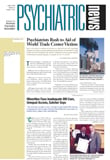Al-Anon, the support program for families and friends of alcoholics, celebrated its 50th anniversary with a Capitol Hill luncheon on September 6. Today there are more than 24,000 Al-Anon groups worldwide.
At times, the event had the spirit of the joyous reunion of a particularly happy family. The two congressional sponsors of the luncheon, Sen. Paul Wellstone (D-Minn.) and Rep. Jim Ramstad (R-Minn.), lauded each other’s efforts on behalf of the federal mental health parity bill that has been introduced in Congress (Psychiatric News, September 7). Wellstone described Ramstad as “someone who had lived through the struggle” with alcoholism and was now using that struggle to inform his ability as a legislator.
Ramstad, in turn, spoke of the pleasure of “working in a nonpartisan way” on the legislation. He said that in 1981, he had awakened in a jail cell because of his alcoholism and added, “I’m here today, alive and sober. I couldn’t have recovered without my family.”
The congressman continued his remarks by offering good news about advances in treatment. “Treatment does work. Families can recover. I tell my colleagues that chemical dependency treatment is more effective than treatment for cancer, and it’s cheaper.”
He went on to describe a bleaker picture of how few people actually get that treatment. “Only 5 percent of addicts and alcoholics are in recovery,” he said. “Eighty-two percent of people in jails are there because of addiction.”
Keynote speaker Claudia Black, Ph.D., a writer and clinical consultant to the Meadows Treatment Center in Wickenburg, Ariz., offered a disheartening list of statistics about the prevalence of alcoholism and its impact on children. Forty-three percent of the U.S. adult population has been exposed to alcoholism in the family. There are an estimated 26.8 million children of alcoholics (COAs) in the United States. Preliminary research suggests that more than 11 million are under the age of 18.
Black, founder and past chair of the National Association for Children of Alcoholics, described the psychological fallout for children living in a family with this disease. “The children wake up in a world that does not take care of them. They learn not to show their feelings, not to talk honestly, not to pay attention to what’s happening around them.”
She cited study data available from the National Clearinghouse for Alcohol and Drug Information that support the anecdotal evidence of damage she observed in her therapeutic work with families. Children living with a nonrecovering alcoholic person score lower on measures of family cohesion, intellectual-cultural orientation, active-recreational orientation, and independence.
COAs have more physical and mental health problems. For example, the rate of total health care costs for children of alcoholics is 32 percent greater than for children from nonalcoholic families. Inpatient admission rates for mental disorders are almost double those for other children.
Hope lies in the many possible points of intervention. Children respond positively to support groups, she said. They can be reached through faith communities and identified by primary care physicians and child welfare workers.
Black added, “We are in denial ourselves if we don’t also focus on the family as a key element in recovery. We know we must retain a patient in a treatment program to get full benefits. A family can provide the necessary motivation, but it can also be the embryo for recidivism. Too often, families are not expected to be part of the recovery process in federally funded programs for people with addiction.”
Related information can be found on these Web sites: National Association for Children of Alcoholics at www.nacoa.net and the National Clearinghouse for Alcohol and Drug Information at www.health.org. ▪
